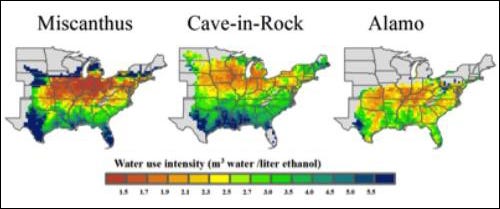Research finds where bioenergy crops would grow best while minimizing detrimental effects on aquatic ecosystems.
February 17, 2016

New research has identified regions in the U.S. where bioenergy crops would grow best while minimizing effects on water quantity and quality.
Researchers at the University of Illinois at Urbana-Champaign used detailed models to examine impacts on water quantity and quality in soils that would occur if existing vegetation was replaced by various bioenergy crops in the name of ethanol production.

This figure shows how much water is used to produced one unit of ethanol (defined as water use intensity) for each energy crop. Source: Atul Jain/University of Illinois.
"We expect the outcome of this study to support scientifically sound national policy decisions on bioenergy crops development, especially with regards to cellulosic grasses," University of Illinois professor of atmospheric sciences Atul Jain wrote regarding a paper published by the journal Environmental Science & Technology.
Currently, corn is the dominant crop used in biofuel production. Research also has revealed that bioenergy grasses such as miscanthus and switchgrasses such as Alamo and Cave-in-Rock cause less nitrogen to be lost due to rain and irrigation than corn. Nitrogen is an important nutrient for crops and a key ingredient in fertilizer, but nitrogen often washes away into rivers and other bodies of water, where it is detrimental to aquatic ecosystems.
Another advantage bioenergy grasses and switchgrasses have over corn is their deep root system, which lets them draw water and nutrients from deeper soil levels and allows them to be more resilient in poor growing seasons.
"Growing bioenergy grasses, in general, can mitigate nitrogen leaching across the United States," said graduate student Yang Song, the study's lead author. "However, the greatest reduction in nitrogen leaching occurs when bioenergy crops displace other cropland or grassland, because energy crops consume more water and less nitrogen fertilizer than the crops and grasses they replace, resulting in less water runoff and nitrogen loss."
By using a combination of crop growth, hydrological, carbon and nitrogen cycle models, researchers found that the estimated land suitable for bioenergy grasses — particularly miscanthus, the most productive bioenergy crop — is limited, despite the relatively high biomass productivity and low water consumption per unit of ethanol.
Specifically, the most suitable regions to grow bioenergy grasses in terms of impact on water (and, ultimately, ethanol production) are eastern Ohio, eastern Kentucky, eastern Tennessee and the North Atlantic regions. Miscanthus and Cave-in-Rock are less suitable in areas like Missouri, southern Illinois and the Mississippi River Watershed regions of eastern Arkansas.
Finally, the researchers found that bioenergy crops do best in regions with higher precipitation rates. They are more likely to fail in drier regions with less frequent and less predictable precipitation, such as the Great Plains, where environmental conditions limit the production of bioenergy grasses. In the Midwest, on the other hand, the grasses are generally able to withstand periodic dry conditions because their roots can grow toward deeper, moister soil.
The research was supported by the National Science Foundation and the U.S. Department of Energy's Office of Science.
You May Also Like

.png?width=300&auto=webp&quality=80&disable=upscale)

